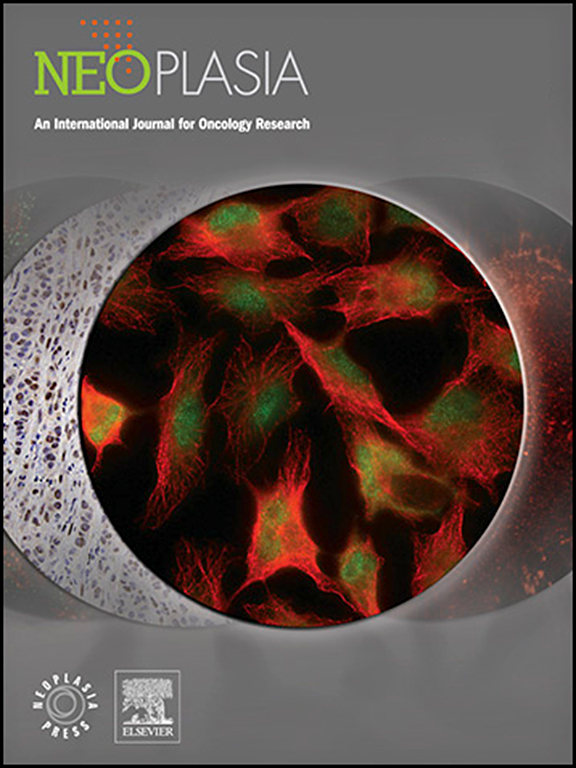Regulatory mechanisms of the Hippo/YAP axis by G-protein coupled estrogen receptor in gastric signet-ring cell carcinoma
IF 7.7
2区 医学
Q1 Biochemistry, Genetics and Molecular Biology
引用次数: 0
Abstract
Although aberrant activation of the Hippo/YAP axis has been implicated in the development of gastric cancer, functional studies of this cascade in the context of gastric signet-ring cell carcinoma (GSRC) remain absent. Our previous single-cell sequencing results showed that G protein-coupled estrogen receptor (GPER) is overexpressed in GSRC, and this overexpression is associated with aberrant activation of the Hippo/YAP axis. In this study, we integrated in vitro cytological functional assays with GSRC cell lines and in vivo xenograft nude mice models to elucidate the functional implications of GPER in GSRC. The overexpression of GPER was identified as being associated with more unfavorable outcomes in GSRC. Its activation facilitated tumor proliferation by YAP nuclear translocation and subsequent transcriptional activation. Mechanistically, GPER inhibited LATS1-mediated YAP phosphorylation by competitively binding to ARRB2, thereby enhancing YAP activity. Moreover, YAP was shown to bind to the GPER promoter, forming a positive feedback loop that reinforced oncogenic signaling. Pharmacological inhibition of GPER using G-15 reduced YAP activation and effectively attenuated tumor aggressiveness, highlighting the GPER-YAP feedback loop as a potential therapeutic target for GSRC. This study underscores the pivotal role of the GPER-YAP positive feedback loop in GSRC and proposes dual inhibition of GPER and YAP as a promising therapeutic strategy for GSRC.

g蛋白偶联雌激素受体在胃印戒细胞癌中Hippo/YAP轴的调控机制
虽然Hippo/YAP轴的异常激活与胃癌的发展有关,但在胃印环细胞癌(GSRC)的背景下,该级联的功能研究仍然缺乏。我们之前的单细胞测序结果显示,G蛋白偶联雌激素受体(GPER)在GSRC中过表达,并且这种过表达与Hippo/YAP轴的异常激活有关。在这项研究中,我们结合了GSRC细胞系和体内异种移植裸鼠模型的体外细胞学功能分析,以阐明GPER在GSRC中的功能意义。GPER的过表达被认为与GSRC中更多的不良结果相关。它的激活通过YAP核易位和随后的转录激活促进肿瘤增殖。在机制上,GPER通过竞争性结合ARRB2抑制lats1介导的YAP磷酸化,从而增强YAP活性。此外,YAP被证明与GPER启动子结合,形成一个强化致癌信号的正反馈回路。G-15对GPER的药理学抑制降低了YAP的激活,有效地减弱了肿瘤的侵袭性,突出了GPER-YAP反馈回路作为GSRC的潜在治疗靶点。这项研究强调了GPER-YAP正反馈回路在GSRC中的关键作用,并提出GPER和YAP的双重抑制是一种有希望的GSRC治疗策略。
本文章由计算机程序翻译,如有差异,请以英文原文为准。
求助全文
约1分钟内获得全文
求助全文
来源期刊

Neoplasia
医学-肿瘤学
CiteScore
9.20
自引率
2.10%
发文量
82
审稿时长
26 days
期刊介绍:
Neoplasia publishes the results of novel investigations in all areas of oncology research. The title Neoplasia was chosen to convey the journal’s breadth, which encompasses the traditional disciplines of cancer research as well as emerging fields and interdisciplinary investigations. Neoplasia is interested in studies describing new molecular and genetic findings relating to the neoplastic phenotype and in laboratory and clinical studies demonstrating creative applications of advances in the basic sciences to risk assessment, prognostic indications, detection, diagnosis, and treatment. In addition to regular Research Reports, Neoplasia also publishes Reviews and Meeting Reports. Neoplasia is committed to ensuring a thorough, fair, and rapid review and publication schedule to further its mission of serving both the scientific and clinical communities by disseminating important data and ideas in cancer research.
 求助内容:
求助内容: 应助结果提醒方式:
应助结果提醒方式:


